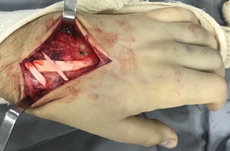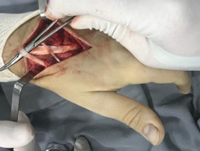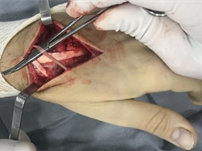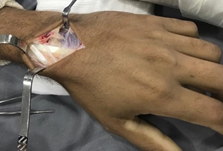Case report
A Rare Supernumerary Extensor Pollicis Longus Tendon: Two Cases Report
- Antonio Tufi Neder Filho 1*
- Lais Gomes Lopes Terra Bagno 1
- Felipe Borges Real Cardoso 1
- Carlucci Martins Lopes 1
- Aedo Khouri Silva 1
Hand Surgery Service, Life center Hospital, Av. do Contorno, Funcionários, Belo Horizonte-MG, Brazil.
*Corresponding Author: Antonio Tufi Neder Filho,Hand Surgery Service, Life center Hospital, Av. do Contorno, Funcionários, Belo Horizonte-MG, Brazil
Citation: A. T. Neder Filho, L. G. L. T. Bagno, F. B. R. Cardoso, C. Martins L. (2023). A Rare Supernumerary Extensor Pollicis Longus Tendon: Two Cases Report. Journal of Clinical Rheumatology and Arthritis, BRS Publishers. 1(2); DOI: 10.59657/2993-6977.brs.23.007
Copyright: © 2023 Antonio Tufi Neder Filho, this is an open-access article distributed under the terms of the Creative Commons Attribution License, which permits unrestricted use, distribution, and reproduction in any medium, provided the original author and source are credited.
Received: July 03, 2023 | Accepted: July 19, 2023 | Published: July 22, 2023
Abstract
This report corresponds to two rare cases in which the accessory extensor pollicis longus was discovered during dorsal wrist surgery of wrist trauma in young people with the need of reconstruction of the scapholunar ligament. These variations consist in two bellies and two tendons of the extensor pollicis longus, coexisting and with the origin in different compartments and the same insertions in the distal phalange of the thumb.
Keywords: anatomical variation; extensor pollicis longus tendon; hand surgery
Introduction
Although a series of anatomical variations of dorsal tendons of the hand have been reported, only few reports of variations of the extensor pollicis longus (EPL) can be found and usually in cadaveric studies. Cauldwell et al reported an incidence of anomaly in the EPL tendon of 1% in a study with 263 cadavers. This rare frequency probably is due to the embryological stability of the EPL [1,2].
It could be one of the least variable muscles of the forearm. Doubling of the extensor longus is not infrequent, and the ulnar portion of the muscle sometimes passes beneath the dorsal anular ligament with the common extensor. The extensor pollicis longus is reported to be absent in about 1.5% of individuals. A slip from the tendon of the long extensor to the extensor indicis is occasionally seen. A rarer variation is an additional extensor between the extensor indicis and extensor pollicis longus, with a double tendon and insertion into both digits. This additional extensor can replace the extensor pollicis longus or extensor indicis [3]. We present two surgical cases with different variations of the long extensor tendon of the thumb.
Cases Report
Case report 1: our first patient was a 19-year-old male medical student who was taken to surgery for treatment of a trans-scaphoid perilunate fracture dislocation after falling off a bicycle. During the surgical approach, an abnormal configuration of the EPL extensors was observed: two tendons corresponding with the EPL. More proximal dissection revealed a separated belly for each EPL tendon, coming from different compartments (Figure 1): one from the third compartment and its course corresponded to the extensor pollicis longus itself (Figure 2) and the anomalous tendon from the fourth compartment (Figure 3). When each tendon was retracted individually, the distal phalanx of the left thumb extended.
Figure 1: Overview of Two Tendons Directed to The Distal Phalanx of The Thumb
Figure 2: Extensor pollicis longus tendon emerging from the third compartment.
Figure 3: supernumerary extensor pollicis longus tendon emerging from the fourth dorsal compartment. It’s remarkable the lesser thickness of the accessory tendon.
Case report 2: our second patient was a 27-year-old male metalworker and engineering student who was taken to surgery for reconstruction of scapholunate ligament. This patient was been previously operated on the opposite hand and no anatomical variation has been noticed. As the first case, was observed two tendons corresponding to EPL, with different origin compartments – third and fourth – and inserting in the distal phalanx of the thumb. By retracting both tendons, the distal phalanx of the left thumb was extended (Figure 4).
Figure 4: supernumerary extensor pollicis tendon emerging from the fourth dorsal compartment.
Discussion
Variations in tendon anatomy are important during surgeries involving repair, transfer of tendons and other conditions. Wood, in 1868, first reported the existence of a supernumerary long extensor to the thumb. Kaplan and Nathan, in 1969, described an accessory muscle and tendon arising adjacent to extensor indicis within the fourth compartment and running parallel to the EPL [4,5].
Beatty et al reported accessory muscle belly arose from the tendon of extensor pollicis longus and lay within the third extensor compartment causing pain and clicking. Culver, in 1980, and Talbot, in 2013, described findings of a supernumerary extensor tendon supplying both index finger and thumb [6,7,8].
Türker et al, in 2010, proposed a two-part classification after a meta-analysis of various reports available in the literature. The first part corresponding to supernumerary long extensor tendons to the thumb divided it in six subtypes. And the second part divided in four subtypes the aberrant interconnections between the long extensor tendon to the thumb and neighboring tendons (Table 1) [9].
Table 1: Classification of ELP variations in two subtypes.
Type 1 Separate Tendons Variations | 1a | Double EPL tendons (different compartiment) |
| 1b | Double EPL (same compartment) | |
| 1c | Double origin of the EPL tendon (different compartment) | |
| 1d | Extensor pollicis tertius | |
| 1e | Extensor pollicis et indicis communis | |
| 1f | Extracompartmental two-slip extensor pollicis tendons | |
Type 2 Interconections of the Extensors Tendons | 2a | Interconnection between EPL and the EIP (the extensor pollicis et indicis accessories) |
| 2b | Interconnection between EPL and EDC2 (junctura tendinum) | |
| 2c | Interconnection between EPL and the extensor apparatus of the index finger (tendon slip from the third compartment) | |
| 2d | Interconnection between EPL and the extensor apparatus of the index finger (tendon slip extracompartimental) |
According to these classifications, both the cases reported in this study were 1a separated bellys, with origin in different compartments (third and fourth) and the insertion in the distal phalange of pollicis [9].
Our cases are relevant since they are wrist traumas in young people with the need of reconstruction of the scapholunar ligament, among other associated techniques. The fact is that they are reconstructive procedures for the biomechanics of the wrist and hand, so it requires anatomical and biomechanical knowledge to reestablish function in the best possible way. The anatomical variations of EPL were occasionally found during the surgical procedure.
The clinical implication of accessory EPL tendons is not clear. Most reports were originated from cadavers, and some studies have shown an association with routine dorsal wrist pain and limitation of range of movement of the thumb [1,2,4]. Even in asymptomatic cases, such ours, there is a concern about the impact of these anomalies on surgical procedures in the forearm, wrist, and hand. Once the stability function was unknown, if these supernumerary tendons are cut or damaged, the surgeon will may face difficulty in establishing anatomy or even reestablishing stability [8].
Conclusion
This article presents two case reports of incidental findings during surgical procedures of rare anatomical variations in the extensor pollicis longus. Our findings may help to increase awareness of such anatomical variation and increase the chance of success of surgical treatment in trauma and planning of reconstructions, tendon repairs and transfers, in addition to avoid possible biomechanical iatrogenic changes after surgery.
References
- Cauldwell EW, Anson BJ, Wright RR. (1943). The extensor indicis proprius muscle. A study of 263 consecutive specimens. Bull Northwestern Univ Med School, 17:267-279.
Publisher | Google Scholor - Sawaizumi T, Nanno M, Ito H. (2003). Supernumerary extensor pollicis longus tendon: a case report. J Hand Surg, 28:1014-1017.
Publisher | Google Scholor - Tubbs RS, Shoja MM, Loukas M. (2016). Bergman’s Comprehensive Encyclopedia of Human Anatomic Variation. Hoboken, New Jersey: John Wiley & Sons.
Publisher | Google Scholor - Wood J. (1868). Variations in human myology observed during the winter session of 1867-68 at King’s College, London. Proc R Soc Lond,16:48-525.
Publisher | Google Scholor - Kaplan EB, Nathan P. (1969). Accessory extensor pollicis longus. Bull Hosp Joint Dis Orthop Inst,30:202-207.
Publisher | Google Scholor - Beatty JD, Remedios D, McCullough CJ. (2000). An accessory extensor tendon of the thumb as a cause of dorsal wrist pain. J Hand Surg, 25:110–111.
Publisher | Google Scholor - Culver JE. (1980). Extensor pollicis and indicis communis tendon: a rare anatomic variation revisited. J Hand Surgery, 5:548-549.
Publisher | Google Scholor - Talbot CE, Mollman KA, Perez NM, Zimmerman AM. (2013). Anomalies of the extensor pollicis longus and extensor indicis muscles in two cadaveric cases. HAND, 8:469-472.
Publisher | Google Scholor - Türker T, Robertson GA, Thirkannad SM. (2010). A classification system for anomalies of the extensor pollicis longus. HAND, 5:403-407.
Publisher | Google Scholor


















